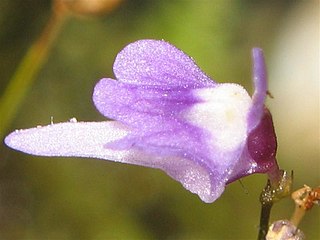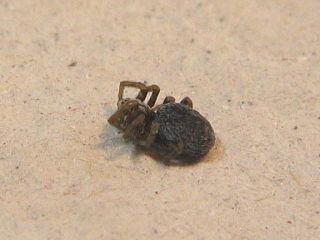
Kleptoparasitism is a form of feeding in which one animal takes prey or other food that was caught, collected, or otherwise prepared by another animal, including stored food. Examples of this last case include cuckoo bees, which lay their eggs on the pollen masses made by other bees, or the hosts of parasitic or parasitoid wasps. The term is also used to describe the stealing of nest material or other inanimate objects from one animal by another.

Dictynidae is a family of cribellate, hackled band-producing spiders first described by Octavius Pickard-Cambridge in 1871. Most build irregular webs on or near the ground, creating a tangle of silken fibers among several branches or stems of one plant.

Ochyroceratidae is a six-eyed spider family, with 165 described species in ten genera. They are common inhabitants of caves and the tropical forest litter of South Africa, the Caribbean, Asia and South America. Considered an ecological counterpart of the Linyphiidae of the northern temperate zone, species are especially diverse in the Indo-Pacific region.
Theotima minutissima is a minute (0.9mm) spider.
Helenoconcha minutissima is an extinct species of gastropod in the family Charopidae. It was endemic to Saint Helena.
Hemistomia minutissima is a species of minute freshwater snails with an operculum, aquatic gastropod molluscs or micromolluscs in the family Hydrobiidae. This species is endemic to Australia, where it is only known from the Erskine Valley, on the southern part of Lord Howe Island.

Utricularia minutissima is a small or very small terrestrial carnivorous plant that belongs to the genus Utricularia. U. minutissima is native to Asia and Australia. Among the islands of Southeast Asia, it is found on Borneo, New Guinea, and Sumatra.
Micronecta minutissima is a species of water boatman in the family Corixidae in the order Hemiptera.

Poecilopachys is a genus of Australasian orb-weaver spiders first described by Eugène Simon in 1895.

Carinapex is a genus of sea snails, marine gastropod mollusks in the family Horaiclavidae.
Lissotesta minutissima is a species of sea snail, a marine gastropod mollusk, unassigned in the superfamily Seguenzioidea.

Spiders are air-breathing arthropods that have eight legs, chelicerae with fangs generally able to inject venom, and spinnerets that extrude silk. They are the largest order of arachnids and rank seventh in total species diversity among all orders of organisms. Spiders are found worldwide on every continent except for Antarctica, and have become established in nearly every habitat with the exceptions of air and sea colonization. As of July 2019, at least 48,200 spider species, and 120 families have been recorded by taxonomists. However, there has been dissension within the scientific community as to how all these families should be classified, as evidenced by the over 20 different classifications that have been proposed since 1900.

Archaeodictyna is a genus of cribellate araneomorph spiders in the family Dictynidae, and was first described by Lodovico di Caporiacco in 1928.

Archaeodictyna ammophila is a spider species found in Europe to Central Asia.

Lasaeola is a genus of comb-footed spiders that was first described by Eugène Louis Simon in 1881. The type species was described under the name Pachydactylus pronus, but was renamed Lasaeola prona when it was discovered that the name "Pachydactylus" was preoccupied. Both this genus and Deliana were removed from the synonymy of Dipoena in 1988, but many of these species require more study before their placement is certain.
Anapis is a genus of araneomorph spiders in the family Anapidae, first described by Eugène Simon in 1895.
Haplinis is a genus of South Pacific dwarf spiders that was first described by Eugène Louis Simon in 1894.
Pseudomicrocentria is a genus of sheet weavers that was first described by F. Miller in 1970. As of May 2019 it contains only two species, both found in Malaysia and South Africa: P. minutissima and P. simplex.
Heradida is a genus of spiders in the family Zodariidae. It was first described in 1893 by Simon. As of 2017, it contains 7 African species.
Theonoe is a genus of comb-footed spiders that was first described by Eugène Louis Simon in 1881.








